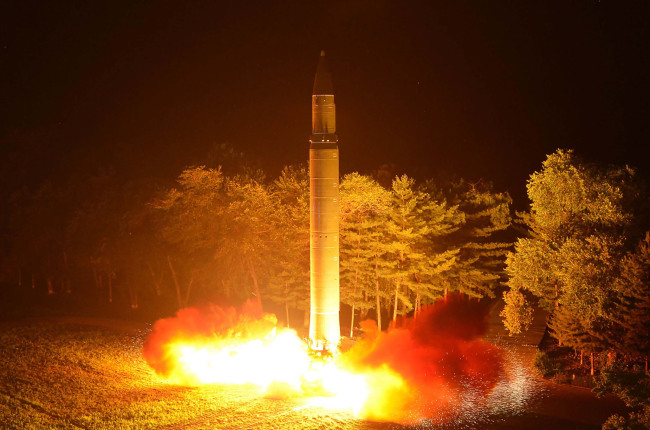North Korea’s latest launch of an intercontinental ballistic missile appeared to be a failure, a Seoul-based missile expert claimed Thursday, suggesting that the Hwasong-14 was not equipped with a stable re-entry system that would allow it to survive the heat-intensive process of re-entering the atmosphere.
Lee Sang-min, a researcher at the Korea Institute for Defense Analyses, said there are “three pieces of scientific evidence” that show the Hwasong-14 test-fired on July 28 lacked the capabilities to enable the warhead to remain intact during re-entry and wreak havoc on the ground
One piece of evidence is that when the missile descended back to Earth from outer space, it did not generate a plasma stream, which should have happened if the projectile had made a successful re-entry, Lee said in his report.
“I don’t see any trace of (plasma) in the Hwasong-14 launch,” he said. “It is highly likely that the missile’s nose cone did not face extreme heat -- or did not ablate uniformly,” he said, adding that the missile could drift off a target if its nose cone is not ablated properly.

Hwasong-14. Yonhap
According to the expert, a straight line of plasma was witnessed in the atmosphere in previous ICBM tests conducted by the US and Russia during the Cold War. It happened regardless of whether it was day or night, he added.
Secondly, the missile failed to show a constant flame before splashing down in waters near the Japanese island of Hokkaido, he said, indicating that the projectile’s warhead could have exploded midair during the re-entry phase.
Citing an image captured by the Japanese broadcaster NHK, the researcher said if the re-entry vehicle had survived the extreme condition of re-entry, it would have continued to glow until disappearing behind the mountains of Hokkaido.
“The form of flame coming out of the Hwasong-14 looks weird,” said Lee. “Considering the fact that the missile’s flame suddenly disappeared and there were no further explosions, I suspect that the warhead could have exploded abnormally.”
The last piece of evidence was that the Hwasong-14 appeared to have exploded at an altitude that was deemed too high to wreak havoc on the ground -- even if the missile was outfitted with a nuclear warhead, Lee added.
According to the image captured by the NHK, the missile’s re-entry vehicle dimmed and quickly disappeared about 3 to 4 kilometers above ground. At this height, even a 20-kiloton nuclear warhead would bring little damage on the ground, Lee claimed.
“North Korea was so ambitious about delivering its weapon to the US continent and convincing the international community to believe it had such capabilities. Their re-entry technology is still in an infant phase,” Lee said.
By Yeo Jun-suk (
jasonyeo@heraldcorp.com)






![[KH Explains] Hyundai's full hybrid edge to pay off amid slow transition to pure EVs](http://res.heraldm.com/phpwas/restmb_idxmake.php?idx=645&simg=/content/image/2024/04/18/20240418050645_0.jpg&u=20240419100350)